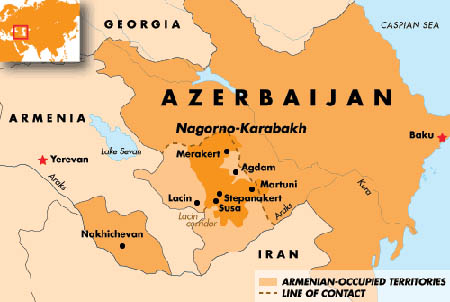 The world hovers on the edge of war, not only in Israel-Palestine, Syria, Ukraine, but in Eurasia’s ground zero, where Armenia and Azerbaijan are always on the cusp of a new outbreak of their unresolvable conflict over Nagorno-Karabakh, an Armenian enclave in the centre of the post-Soviet ‘republic’ of Azerbaijan.
The world hovers on the edge of war, not only in Israel-Palestine, Syria, Ukraine, but in Eurasia’s ground zero, where Armenia and Azerbaijan are always on the cusp of a new outbreak of their unresolvable conflict over Nagorno-Karabakh, an Armenian enclave in the centre of the post-Soviet ‘republic’ of Azerbaijan.
Oil-rich Azerbaijan is lavishing its petro-dollars on beefing up its armed forces, assisted by--guess who?--Russia and Israel. It seems only a matter of time till a full scale explosion happens. It almost did in April, 2016, when Armenian forces in Karabakh shelled civilian settlements and attacked Azerbaijani forces in retaliation for an Azerbaijani helicopter firing on Armenian military positions. 18 Armenian and 12 Azerbaijani troops were killed. Given Azerbaijan’s growing military teeth, it is unlikely the Armenians started this.
This is yet another intractable dilemma resulting from the sudden collapse of the Soviet Union. Soviet borders were not carved out in the 1920s with western-style sovereignty in mind, and now many make no sense at all within the western legal framework.
To compound its loss of Karabakh (visualize the western corridor through East Germany to West Berlin), Azerbaijan’s Nakhchivan Autonomous Republic (the size of Delaware) is orphaned on the other side of Armenia. Like both Armenia and Azerbaijan, Nakhchivan is totally landlocked, and has no link with its motherland for two decades. What is the secret that keeps it going? For that matter, what keeps pesky Armenia, flouting international law, wedged between hostile Turkey, tiny Georgia and Iran, going?
The parallels between Armenia and Israel, Armenians and Jews, are remarkable, and provide answers. They span geopolitics, religion, tribalism, economics, culture and a history of tragic dimensions. They account for both ethnicities’ triumphs in the face of determined enmity, but also their failure to find peace among nations.
Illegal occupation
The most stark parallel is the seizure of neighbouring territories with no intention of returning them, and (almost) universal condemnation. The 1988 war resulted in 40,000 deaths, 230,000 Armenians and a million Azeris displaced, and the 1994 ceasefire agreement between Armenia and Azerbaijan, followed by fruitless peace negotiations.
Armenia has not yet implemented four UN Security Council resolutions on withdrawal of its armed forces from the Nagorno-Karabakh and the surrounding districts, stubbornly insisting Karabakh is Armenian land.
Sound familiar? Though Israel’s actions are far worse, having occupied all its neighbour’s territories, and spent decades adding settlers from Russia and the US, who have no historic bond to the territories and no intention of giving up their free accommodations.
Geopolitics
Both countries achieved ‘independence’ only in the 20th century, despite their ancient and larger-than-life histories. The reason being their key locations on the map -- both at crossroads which have seen invasions and occupations over the millennia which at various times have tried to stamp these stubborn tribes out or at least make them integrate.
The 19th--20th century version -- for the Armenians, the Ottoman Turks and the Russian communists -- for the Jews in Europe, the Nazis, in Palestine, the British. Both tribes survived their occupiers and overlords, and have maintained their fierce pride and independence.
Armenia claims to be the oldest Christian state (301 AD), and, of course, Judaism claims to be the cradle of all monotheisms. The strong fusion of religion and ethnicity has kept these small tribes united in the face of annihilation.
Being at a crossroads means constant cultural stimulation and the need to keep one step ahead of one’s nemeses. Armenia’s location is of less strategic importance today than Israel’s, and Armenians are not key world players economically, so they don’t capture headlines in the West, but their current position is just as perilous as that of Israel.
Russian Communism
Armenia’s natural affinity is with fellow Orthodox Christian Russia, which threatened Ottoman hegemony in the region and then Turkish independence in 1920. This is what prompted the expulsion and mass killing of up to a million Armenians and destruction of their millennial architectural treasures by the Turks starting in 1915. A similar mass pogrom of Jews in Europe took place starting a few years later, also prompted by WWI, Jews being seen as a threat to German culture.
The Russian communists were welcomed by the Armenians--anyone was better than the Turks. Though the Russian revolution aimed to dismantle the old tribalisms and create a new generic Soviet Man, the Armenians blossomed in their soviet republic founded in 1921. The wily Anastas Mikoyan was the only soviet politician who managed to remain at the highest levels of power within the Communist Party of the Soviet Union under Lenin, Stalin, Khrushchev and Brezhnev.
The even wilier (mostly communist) Jews created their state in 1948 with the help of the the Soviet Union, but quickly sold out in the Cold War, jumping on the anti-Soviet bandwagon, and found their place in the sun--at least for now.
This perceived betrayal of its Soviet sponsors poisoned the otherwise elite position that the talented Soviet Jews had in their soviet motherland, and as the lure of the West took hold, Soviet Jews were resented and restricted, in a vicious circle that encouraged them--with US support--to emigrate, a key element in the Soviet Union’s collapse.
Diasporas
Armenia has a population of 3.2m, Israel 8.5m. Armenia has a diaspora of 8m, Israel -- 13.2m. Both diasporas are the secret of their success, providing both economic and political support for the ‘motherland’.
Armenia suffered much less emigration following the collapse of the Soviet Union than did other ‘republics’, and there is steady population growth and even repatriation of the diaspora. There are Armenians scattered virtually everywhere around the world (Russia, France, Iran, the US (500,000), Georgia, Syria, Lebanon, Argentina, Australia, Canada, Greece, Cyprus, Israel, Poland, Ukraine and Brazil. About 1,000 Armenians reside in the Armenian Quarter in the Old City of Jerusalem, a remnant of a once-larger community.
40,000 to 70,000 Armenians still live in nemesis Turkey (mostly in and around Istanbul), but none in neighbouring Azerbaijan, which lost 20% of its territory to tiny Armenia in the early 1990s, and ‘ethnically cleansed’ its large Armenian population.
The prize, the ancient Armenian enclave Nagorno-Karabakh lies at the heart of Azerbaijan, creating an insoluble problem which is really no one’s fault, yet another poisonous legacy of the US obsession with destroying the Soviet Union, where such ethnic chauvinism was strongly discouraged, and where borders were not important.
Genocide and/or holocaust
Interestingly, Armenia and Israel have at best cordial relations, though you might expect greater empathy for fellow sufferers. The problem is on the surface a linguistic quibble. Jews, or at least Israel, insist that ‘holocaust’ is their cross to bear, and refuse to use even the ‘g’ word for Armenia’s tragedy.
The Armenians were left defenseless in 1915 after the Russians withdrew from Ottoman territory they had briefly occupied, hoping to keep as spoils. Their tragedy inspired Raphael Lemkin, a lawyer of Polonized-Jewish descent to coin the word “genocide” in 1943* with the Armenians and Jews in mind, and to propose the Genocide Convention after WWII (from the rooted words genos (Greek for family, tribe, or race) and -cide (Latin for killing)).
Perhaps the Israeli refusal to use the ‘g’ word--let alone the ‘h’ word--for others is chauvinism or just wily geopolitics. Armenia is much less important than Turkey. To commemorate the Armenian 100th anniversary in 2015, Pope Francis described it as the "First genocide of the XX century", causing a diplomatic row with Turkey. The Pope calling on the world to recognize "the truth of what transpired and oppose such crimes without ceding to ambiguity or compromise."
Pope Francis boldly decided to travel to Yerevan in June 2016 to honour the Armenians and affirm his call for Turkey to own up to its history. At the same time, he urged Armenia and Turkey to seek reconciliation and to shun "the illusory power of vengeance," and called for meaningful peace talks with Azerbaijan that would end the state of war between them.
Turkey and Azerbaijan insist there was no mass slaughter at all. Israel, Britain and United States still refuse to add even the ‘g’ word to their political lexicon as relates to Armenia, a shameful political sop to both Turkey and Israel. Turkey is a much needed Muslim member of NATO, and Israel is at the heart of western imperialism. Armenia just has to grin and bear it.
xxxx
*Lemkin had proposed a convention outlawing mass slaughter to the League of Nations in 1933, based on the Armenian experience. He escaped German capture in 1941 and emigrated via Sweden to the US, losing 49 relatives to the Nazis.
Part II
at "War and Peace Part II: Azerbaijan and Palestine"





